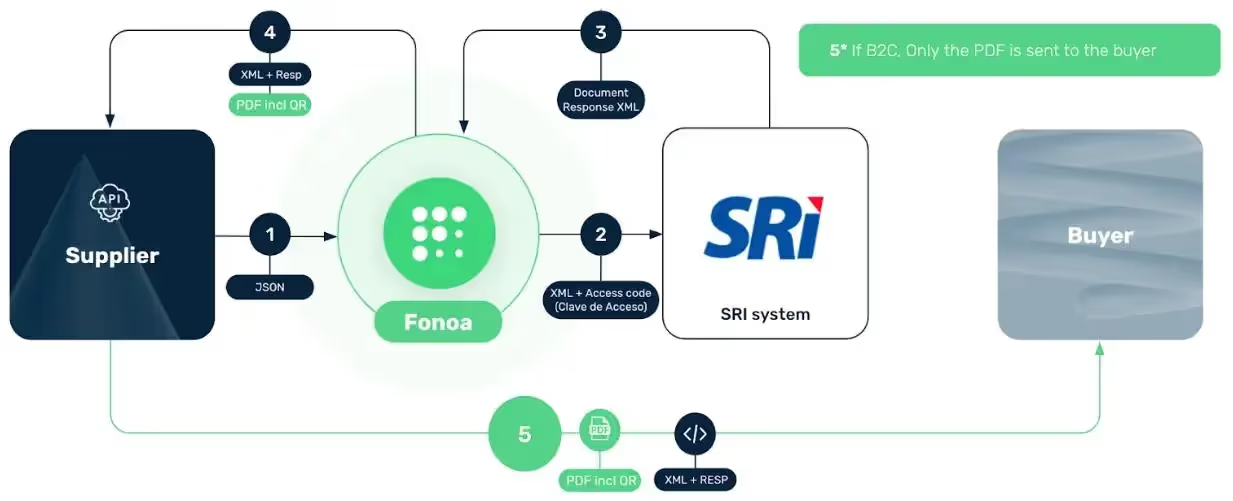Ecuador has mandatory electronic invoicing for all taxpayers, including non-residents meeting specific thresholds. Businesses must generate XML invoices, obtain authorization from the Internal Revenue Service (SRI - Servicio de Rentas Internas) and use a digital signature for authenticity. E-invoices should be sent to the SRI within 24 hours, and taxpayers must store both the XML file and the SRI acceptance message.
This guide will cover e-invoicing in Ecuador, including its requirements, mandates, and steps businesses should take.
How does the e-invoicing system work in Ecuador?
Ecuador implemented mandatory electronic invoicing in 2015 to modernize tax administration and enhance fiscal control. The SRI system requires all taxpayers to generate electronic invoices in a specific XML format that must be validated and certified by the Ecuadorian tax authority. Businesses must obtain a digital signature from an authorized certification authority (CA) in Ecuador to ensure the authenticity and integrity of these invoices. Non-residents exceeding 20k USD in annual turnover threshold are also required to issue electronic invoices.
To issue e-invoices, businesses must register with the Internal Revenue Service (SRI) and obtain authorization. They must also request certification for testing and production environments directly through the SRI WEB Portal.
Electronic invoices must be signed with an Advanced Electronic Signature (AES), a cryptographic mechanism to verify electronic documents' authenticity and integrity. The AES is based on a Public Key Infrastructure (PKI) system and uses a digital certificate issued by a Certification Authority (CA) to verify the e-signature's authenticity. Service providers and businesses must ensure AES is applied to invoices to provide evidence of sender authenticity and data integrity. In order to obtain a AES, one can visit the website of the Central Bank of Ecuador, click "Electronic Signature" > "Certificate Request", complete the form and attach required documents in PDF format. Once approved, pay at the General Directorate of Civil Registry and obtain your electronic signature.
The SRI system requires businesses to generate electronic invoices in a specific XML format, which must be validated and certified by the tax authorities. After issuing a document, it is mandatory to send it to the SRI within 24 hours. Taxpayers are required to keep both the XML file and the SRI approval message for their records.
Compliance with e-invoicing is mandatory for all types of businesses, whether manufacturing, retail, service-oriented, or any other type operating in Ecuador. The e-invoicing system has increased transparency, reduced administrative burdens, minimized tax evasion, and facilitated faster and more efficient tax processing. Additionally, it has paved the way for other digital tax initiatives, such as electronic books of sales and purchases.
How does the e-invoicing process look in practice?
- Creation: The invoice is created according to the data continent and format requirements of SRI. The invoice must contain certain mandatory information, including the taxpayer’s identification number, the buyer’s identification number, the invoice date, and the amount of the transaction.
- Signed: Using the electronic signature certificate and a digital signature algorithm, the invoice is signed so that the SRI can verify its legitimacy.
- SRI sending: The invoice is sent to the SRI to be processed.
- SRI authorization consultation: After a waiting period, SRI consults the authorization of the invoice.
- Returning documents to issuer: The digitally signed invoice, the SRI response and a graphical representation PDF must be delivered delivered to the buyer in a method or form that the trading parties agree on.
- Storage: Both trading parties must keep a copy of the invoice for seven years.

Once an electronic document is sent to the SRI, it can have multiple states:
- In Processing (PPR): this is a temporary status during which the SRI is still processing the document sent. It should be noted that the maximum time it will take for the SRI to process an electronic document will be 24 hours.
- Authorized (AUT): the electronic document has been formally authorized by the SRI.
- Unauthorized (NAT): When the electronic voucher is in a non-authorised state (NAT), the issuer will be obliged to correct and send the electronic invoice again through the WEB Service and subsequently notify and deliver to the recipient: recipient or subject withheld the new email receipt, via email. It should be clarified that the maximum time it will take for the SRI to process an electronic invoice will be 24 hours.
Note: It is the obligation of the recipients of the electronic documents to validate them through the SRI WEB portal.
What document types are available?
There are six types of electronic documents that taxpayers can issue.
- Invoices (01): the electronic invoice is a method of issuing sales invoices that meets the legal and regulatory requirements for authorization by the SRI, guaranteeing the authenticity of its origin and integrity of its content, since it includes the signature email from the issuer on each invoice.
- Liquidations of purchases of goods and provision of services (03): these documents must be issued and delivered by taxpayers for certain acquisitions established in the Ecuadorian legal framework.
- Credit notes (04), debit notes (05): these documents allow taxpayers to amend or modify previously issued valid invoices.
- Reference (Remittance) guides (06): these documents support the transfer of merchandise within the national territory, so all transport must carry them.
- Withholding Statements (07): this type of voucher is issued to indicate tax withholdings made by withholding agents authorized by local legislation.
Details of aspects of consideration
Digital signatures
Electronic invoices must be signed with an Advanced Electronic Signature (AES), a cryptographic mechanism to verify electronic documents' authenticity and integrity. The AES is based on a Public Key Infrastructure (PKI) system and uses a digital certificate issued by a Certification Authority (CA) to verify the e-signature's authenticity. Service providers and businesses must ensure AES is applied to invoices to provide evidence of sender authenticity and data integrity.
Unique access code “Clave de acceso única”
Each electronic document generated by taxpayers must include a unique access key of 49 numerical digits. This key is automatically generated by Fonoa and serves as the document's unique identifier and authorization number. Once submitted, the SRI will verify the access key to either authorize or reject the document. This mandatory requirement makes each electronic document unique and ensures its authenticity. The SRI generates a response based on the access key to authorize or reject the invoice or electronic document sent.
The verifier digit will be applied to the entire access key (48 digits) and must be incorporated by the taxpayer through the method called “Module 11”. See bellow an example of how to obtain a verification digit using Module 11.
Verification array: 41261533
Steps 1 & 2: Multiple each digit by a pre-set amount

Step 3: Add the previous results
Step 4: Compute the remainder when you divide the previous results by 11
Step 5: Subtract the previous number from 11
Invoice number
The number of an invoice or any other receipt is made up of 15 digits, the first three numbers indicate the number of the establishment according to the RUC (001), the next three correspond to the POS number (001) and the last 9 digits are the Sequential number of the invoice number itself. Fonoa also automatically manages this.
Printed representation (RIDE)
The current regulations for electronic invoices in Ecuador require specific provisions for the printed representation of electronic receipts (RIDE). These printed representations must include a barcode that follows GS1-128 international standards and adheres to the specific format defined in annexes 2 and 7 of the technical data sheet of the user manual.
The SRI does not have a mandatory format for both paper invoices and the physical representation of electronic invoices. However, they provide a suggested format widely followed by taxpayers in Ecuador, which Fonoa uses to create its own template.
How can Fonoa help?
Fonoa offers a complete solution with plug-and-play capabilities for global e-invoicing requirements, including those in Ecuador.
Our innovative platform ensures seamless implementation and easy compliance with tax regulations globally. We provide excellent customer service with support at every step of the process. Our unified API enables quick implementation, and we can offer assistance in just a few weeks.
Get in touch with us for more details.
















